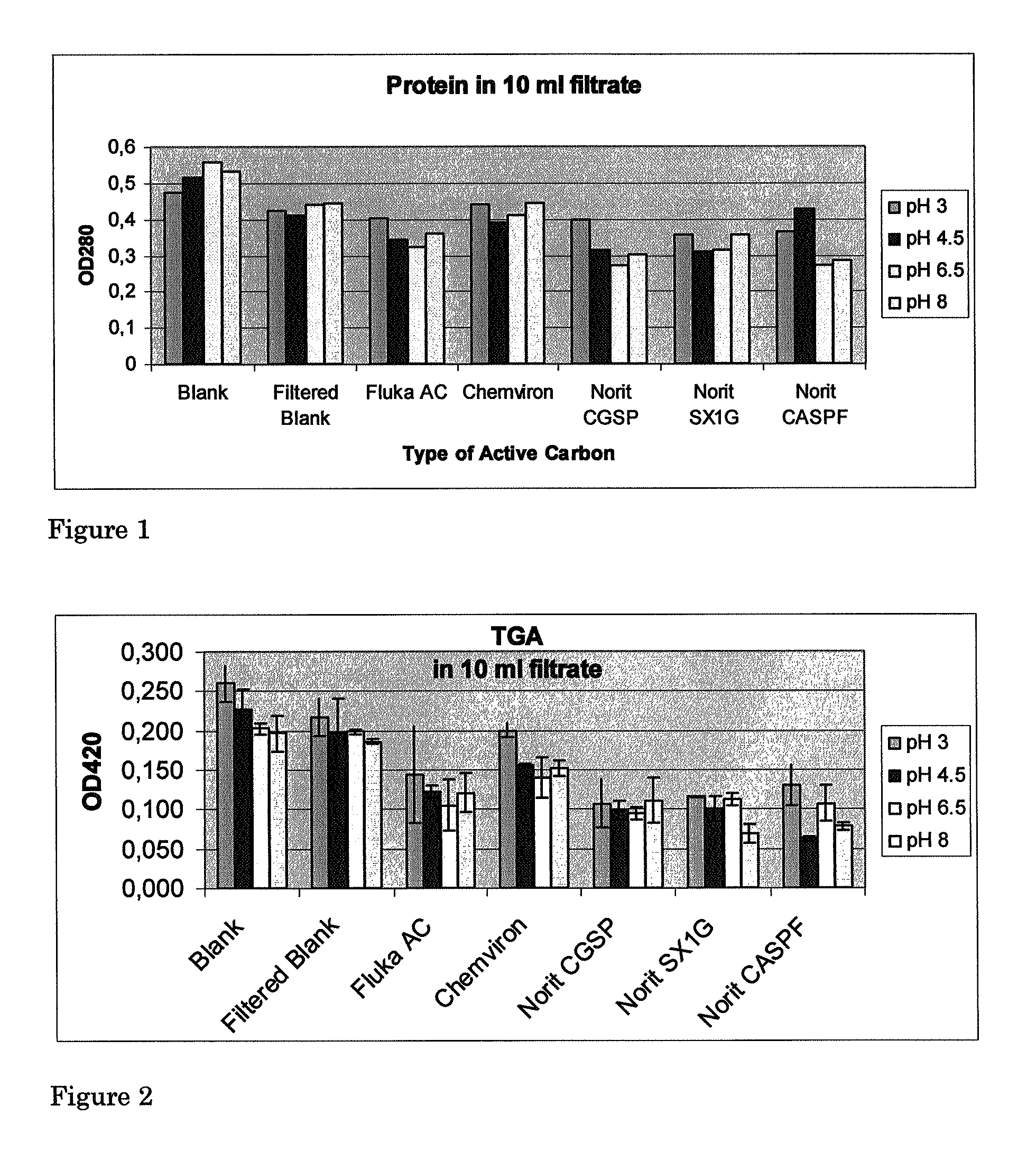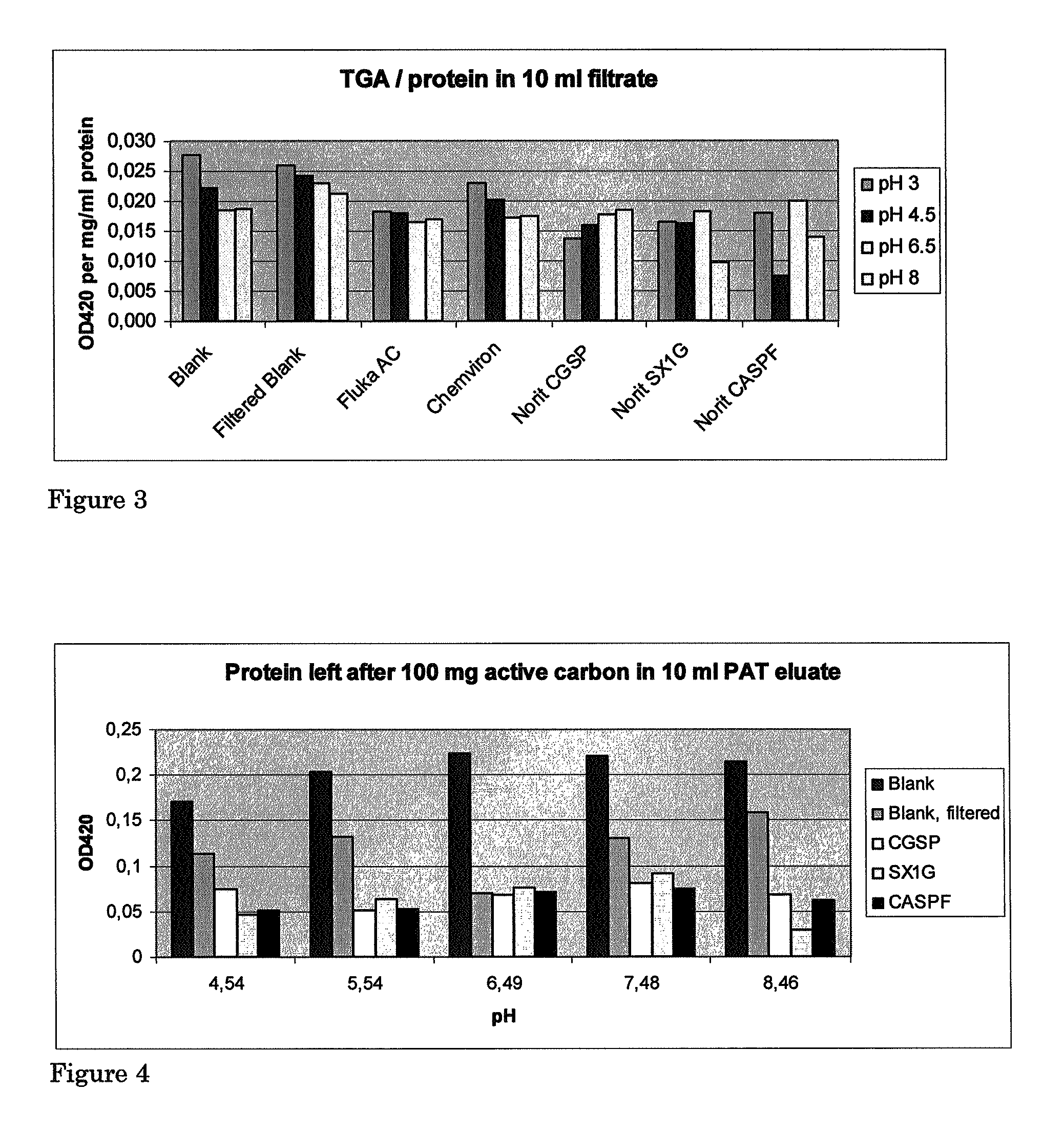Glycoalkaloid removal
a glycoalkaloids and glycoalkaloids technology, applied in the field of glycoalkaloids removal, can solve the problems of limiting the application of known native potato protein isolates in foods, unable to detect aglycons formed by enzymatic hydrolysis, and complex separation and isolation of minimally denatured or modified potato proteins, etc., to achieve the effect of effective and complete removal of glycoalkaloids
- Summary
- Abstract
- Description
- Claims
- Application Information
AI Technical Summary
Benefits of technology
Problems solved by technology
Method used
Image
Examples
example 1
[0057]Procedure: protease inhibitors eluate, as obtained in Example 1 method 10 of the European patent application no. 06077000.5, was exposed to 5 different varieties of active carbons at 4 different pHs. Activated carbons tested: Chemviron® Carbon pellets, Fluka® 05105 Active Charcoal, Norit® CASPF, SX1G, CGSP.
[0058]0.10 g Active Carbon of each type was weighed and placed in a 15 ml plastic tube. 70 ml protease inhibitors eluates were adjusted to pHs of 2.97, 4.57, 6.51 or 8.04 with 100% HAc, 1 M or 4 M NaOH respectively. 10 ml of each pH-adjusted protease inhibitors eluate were added to each tube, which were incubated at ambient temperature for 120 minutes. Per pH tested, two tubes were not exposed to active carbon. One of these tubes was kept as a blank, while the other was subjected to filtration under identical conditions as the carbon-containing samples.
[0059]Active carbon was separated from the eluate by filtration of Schleicher & Schuell 595 70 mm filters in a Buchner-funne...
example 2
[0065]Procedure: patatin eluate, as obtained in Example 1 method 9 of the European patent application no. 06077000.5 was exposed to 3 different varieties of active carbons at 5 different pH values.
[0066]Materials: Norit® CASPF, SX1G, CGSP.
[0067]0.10 g Activated Carbon of each type was weighed and placed in a 7 ml falcon tube. 70 ml patatin eluates were adjusted to pHs of 4.54, 5.45, 6.49, 7.48 or 8.46 with 100% HAc, 1 M or 4 M NaOH. 10 ml of every fraction were added to the tubes and incubated under rotation at ambient temperature for 120 minutes. For every pH two tubes were kept as controls without carbon. One of these was subjected to filtration while the other was not. Activated carbon was separated from the eluate by Büchner-filtration over a 70 mm Schleicher & Schuell 595 filter using a water aspirator. The filtrates were stored for protein and TGA determination via appropriate protocols. The results are shown in Table 4 and FIGS. 4, 5 and 6.
[0068]
TABLE 4RatioTGAProteinTGAOD 42...
example 3
[0070]Adsorption materials used: for the SX 1 G carbon the corresponding granular form is GAC 1240+, for the CASPF form C-GRAN is the corresponding granular carbon. The columns with a length of 100 cm and a diameter of 6 cm were loaded with 1.7 liters of degassed GAC1240+(Norit, The Netherlands) per column for a total bed depth of 60 cm per column. This is the minimal depth required to prevent channeling in the carbon bed.
[0071]Patatin eluate, as obtained in Example 1 method 9 of the European patent application no. 06077000.5, and a concentrate of same eluate of 1.1 brix and 3.9 brix respectively were run over the carbon beds of two columns each with a residence time of 30 minutes, corresponding to approximately 14 ml per hour. After each column fractions were collected and analysed for brix, pH, conductivity, OD 280 nm and TGA content via the colorimetric and HPLC method. The results are shown in the Tables 5 and 6.
PUM
| Property | Measurement | Unit |
|---|---|---|
| Temperature | aaaaa | aaaaa |
| Fraction | aaaaa | aaaaa |
| Fraction | aaaaa | aaaaa |
Abstract
Description
Claims
Application Information
 Login to View More
Login to View More - R&D
- Intellectual Property
- Life Sciences
- Materials
- Tech Scout
- Unparalleled Data Quality
- Higher Quality Content
- 60% Fewer Hallucinations
Browse by: Latest US Patents, China's latest patents, Technical Efficacy Thesaurus, Application Domain, Technology Topic, Popular Technical Reports.
© 2025 PatSnap. All rights reserved.Legal|Privacy policy|Modern Slavery Act Transparency Statement|Sitemap|About US| Contact US: help@patsnap.com



